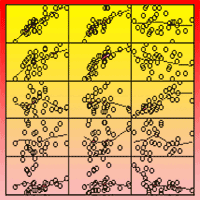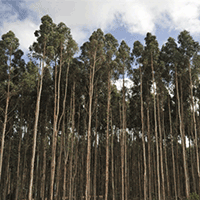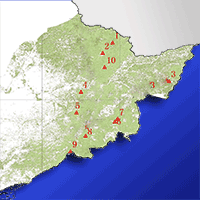
Adaptability and interspecific variability in growth and leaf traits of eucalypt
Chrissy Garel Makouanzi Ekomono (1-2-3) , Castela Bath Shéba Vitel Loubassou (3), Mavie Parfait Mbama (4), Grace Jopaul Loubota Panzou (5), Philippe Vigneron (6)
iForest - Biogeosciences and Forestry, Volume 14, Issue 6, Pages 560-568 (2021)
doi: https://doi.org/10.3832/ifor3660-014
Published: Dec 09, 2021 - Copyright © 2021 SISEF
Research Articles
Abstract
Effective adaptability of plants to new environments can be analysed in terms of survival rate. Analysing the traits that favour adaptation to environmental changes provides a more in-depth understanding of the mechanisms involved. Local adaptation occurs because different environmental factors exert selective pressure across habitats. Understanding the leaf mechanisms underlying plant survival and growth is crucial to determine why local adaptation involves trade-offs. A comparative provenance test on 29 eucalyptus species was conducted to improve our understanding of species adaptation strategies on coastal plains of Pointe-Noire, Republic of the Congo. We studied the different functional traits to determine how plants function and to highlight the different species’ adaptive strategies. For each species, survival, growth traits and leaf traits were measured, and the climatic factors of the origin area for each species was taken into account. Cluster analysis was performed on groups of species with a similar growth strategy. The results revealed general trends that explain the physiological mechanisms involved in the species’ local adaptation. Indeed, species have survived to current environmental changes by adjusting their specific leaf area plasticity. The 32 provenances of eucalyptus were subdivided into four groups by cluster analysis. The first cluster included two species (E. pilularis and E. peltata) that are totally unsuited to the local conditions in Pointe-Noire, with the slowest growth rate and smallest specific leaf area. The second cluster contained species that showed a wide variety of growing strategies, allowing them to adapt to local conditions. The third cluster included a species that is specialised in obtaining large quantities of resources, while investing very little in growth. The fourth cluster included species that acquired and used resources at a slow rate. Leaf anatomy was quite responsive to climatic conditions. We evaluated the different strategies and found that eucalyptus species had very diverse functional traits, which may explain their broad ecological range.
Keywords
Adaptability, Eucalyptus, Foliar Traits, Growth Strategies, Clustering Analysis
Authors’ Info
Authors’ address
Ecole Nationale Supérieure d’Agronomie et de Foresterie (ENSAF), Marien Ngouabi University, Brazzaville (Republic of the Congo)
Centre de Recherche sur la Durabilité et la Productivité des Plantations Industrielles - CRDPI, Pointe-Noire (Republic of the Congo)
Castela Bath Shéba Vitel Loubassou
Institut National de Recherche Forestière - IRF, Brazzaville (Republic of the Congo)
Programme National d’Afforestation et de Reboisement - PRONAR, Brazzaville (Republic of the Congo)
Laboratoire de Biodiversité, Gestion des Ecosystèmes et de l’Environnement - LBGE, Faculté des Sciences et Techniques, Université Marien Ngouabi, BP 69 Brazzaville (Republic of the Congo)
Centre de Coopération International de Recherche en Agronomie pour le Développement - CIRAD, UMR AGAP, Amélioration Génétique et Adaptation des Plantes Tropicales et Méditerranéennes, Montpellier (France)
Corresponding author
Paper Info
Citation
Makouanzi Ekomono CG, Loubassou CBSV, Mbama MP, Loubota Panzou GJ, Vigneron P (2021). Adaptability and interspecific variability in growth and leaf traits of eucalypt. iForest 14: 560-568. - doi: 10.3832/ifor3660-014
Academic Editor
Rossella Guerrieri
Paper history
Received: Sep 26, 2020
Accepted: Oct 10, 2021
First online: Dec 09, 2021
Publication Date: Dec 31, 2021
Publication Time: 2.00 months
Copyright Information
© SISEF - The Italian Society of Silviculture and Forest Ecology 2021
Open Access
This article is distributed under the terms of the Creative Commons Attribution-Non Commercial 4.0 International (https://creativecommons.org/licenses/by-nc/4.0/), which permits unrestricted use, distribution, and reproduction in any medium, provided you give appropriate credit to the original author(s) and the source, provide a link to the Creative Commons license, and indicate if changes were made.
Web Metrics
Breakdown by View Type
Article Usage
Total Article Views: 31535
(from publication date up to now)
Breakdown by View Type
HTML Page Views: 26735
Abstract Page Views: 2425
PDF Downloads: 1839
Citation/Reference Downloads: 5
XML Downloads: 531
Web Metrics
Days since publication: 1488
Overall contacts: 31535
Avg. contacts per week: 148.35
Citation Metrics
Article Citations
Article citations are based on data periodically collected from the Clarivate Web of Science web site
(last update: Mar 2025)
(No citations were found up to date. Please come back later)
Publication Metrics
by Dimensions ©
Articles citing this article
List of the papers citing this article based on CrossRef Cited-by.
References
Les eucalyptus introduits au Congo 1953-1981 [Eucalyptus introduced to Congo 1953-1981]. Note interne CTFT, Pointe-Noire, Republic of Congo, pp. 100.
Gscholar
The plant traits that drive ecosystems: evidence from three continents. Journal of Vegetation Science 15: 295-304.
CrossRef | Gscholar
Evaluation of newly introduced Eucalyptus camaldulensis provenances in Egypt. Alexandria Journal of Agricultural Research 28: 309-319.
Gscholar
Coping with climate change - the roles of genetics resources for food and agriculture. Food and Agriculture Organization of the United Nations, Rome, Italy, pp. 130.
Gscholar
Adaptation and mitigation in tropical tree plantations. In: “Climate Change and Agriculture Worldwide” (Torquebiau E ed). Springer, Dordrecht, Netherlands, pp. 197-208.
CrossRef | Gscholar
Elastic and osmotic adjustments in rooted cuttings of several clones of Eucalyptus camaldulensis Dehn. from southeastern Australia after a drought. Flora - Morphology, Distribution. Functional Ecology of Plants 197: 134-142.
CrossRef | Gscholar
Climate change and forest genetic resources: state of knowledge, risks and opportunities. Commission on Genetic Resources for Food and Agriculture, FAO Background Study Paper No. 56, Food and Agriculture Organization of the United Nations, Rome, Italy, pp. 29.
Online | Gscholar
Caractérisation minéralogique des sols ferralitiques sableux sous plantation d’Eucalyptus et sous savane naturelle de la région de Pointe-Noire (Congo). [Mineralogical characterization of sandy ferralitic soils under Eucalyptus plantation and natural savannah in the Pointe-Noire region (Congo)]. Rapport UR2PI, Pointe-Noire, Republic of Congo, pp. 51. [in French]
Gscholar
Provenance productivity in Eucalyptus camaldulensis and its implications to genetic improvement in the savanna region of Nigeria. Silvae Genetica 121-126.
Gscholar
New handbook for standardised measurement of plant functional traits worldwide. Australian Journal of Botany 61 (3): 167.
CrossRef | Gscholar
Etude du système racinaire de l’Eucalyptus en plantation tropicale: analyse architecturale, croissance et respiration. [Study of the root system of Eucalyptus in tropical plantations: architectural analysis, growth and respiration]. Thèse de l’Université Henri Poincaré, Nancy I et de l’Université Marien Ngouabi, Brazzaville, Republic of Congo, pp. 183. [in French]
Online | Gscholar
Functional traits as indicators of biodiversity response to land use changes across ecosystems and organisms. Biodiversity Conservation 19: 2921-2947.
CrossRef | Gscholar
The worldwide leaf economics spectrum. Nature 428 (6985): 821-827.
CrossRef | Gscholar

















